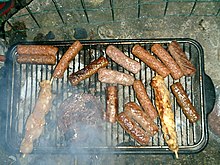
Back Rooster Afrikaans شواء Arabic ܛܘܘܝܐ ARC Graellada Catalan Grilování Czech Grillen German Kradrostaĵo Esperanto A la parrilla Spanish Grillimine Estonian کباب کردن شبکهای Persian
This article has multiple issues. Please help improve it or discuss these issues on the talk page. (Learn how and when to remove these messages)
|



Grilling is a form of cooking that involves heat applied to the surface of food, commonly from above, below or from the side.[1] Grilling usually involves a significant amount of direct, radiant heat, and tends to be used for cooking meat and vegetables quickly. Food to be grilled is cooked on a grill (an open wire grid such as a gridiron with a heat source above or below), using a cast iron/frying pan, or a grill pan (similar to a frying pan, but with raised ridges to mimic the wires of an open grill).
Heat transfer to the food when using a grill is primarily through thermal radiation. Heat transfer when using a grill pan or griddle is by direct conduction. In the United States, when the heat source for grilling comes from above, grilling is called broiling.[2] In this case, the pan that holds the food is called a broiler pan, and heat transfer is through thermal radiation.
Direct heat grilling can expose food to temperatures often in excess of 260 °C (500 °F). Grilled meat acquires a distinctive roast aroma and flavor from a chemical process called the Maillard reaction. The Maillard reaction only occurs when foods reach temperatures in excess of 155 °C (310 °F).[3]
Not all foods are suitable for grilling. Grilling is an inappropriate treatment for large, tough cuts of meat as this fast technique would not allow the meat to cook slowly and tenderise. When using the grilling method, food is usually placed on a heat-resistant wire rack. This allows the fat, excess oils or juices to drain away.[4]
Studies have shown that cooking beef, pork, poultry, and fish at high temperatures can lead to the formation of heterocyclic amines, benzopyrenes, and polycyclic aromatic hydrocarbons, which are carcinogens.[5][6] Marination may reduce the formation of these compounds.[7] Grilling is often presented as a healthy alternative to cooking with oils, although the fat and juices lost by grilling can contribute to drier food.[8]
- ^ "Heat in Cooking - University of Kentucky" (PDF). Archived (PDF) from the original on 13 November 2016. Retrieved 12 November 2016.
- ^ "broiling: Information from". Answers.com. Archived from the original on 27 December 2014. Retrieved 1 February 2015.
- ^ Schröder, Monika J.A. (2003). Food Quality and Consumer Value: Delivering Food that Satisfies. Berlin: Springer. p. 150. ISBN 3540439145. Archived from the original on 11 June 2016. Retrieved 10 February 2017.
- ^ "Cooking methods" (PDF).
- ^ Sugimura, Takashi; Wakabayashi, Keiji; Nakagama, Hitoshi; Nagao, Minako (April 2004). "Heterocyclic amines: Mutagens/carcinogens produced during cooking of meat and fish". Cancer Science. 95 (4): 290–299. doi:10.1111/j.1349-7006.2004.tb03205.x. PMC 11159436. PMID 15072585. S2CID 37343288. Archived from the original on 19 June 2010. Retrieved 1 February 2015.
- ^ "Chemicals in Meat Cooked at High Temperatures and Cancer Risk - National Cancer Institute". Cancer.gov. Archived from the original on 21 December 2010. Retrieved 1 February 2015.
- ^ "Health | Marinating 'may cut cancer risk'". BBC News. 30 December 2008. Archived from the original on 31 December 2008. Retrieved 1 February 2015.
- ^ Beckett, Fiona (2012). Sausage & Mash. London: Bloomsbury Publishing. p. 16. ISBN 9781408187760. Retrieved 10 February 2017.